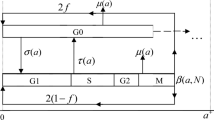Abstract
A nonlinear structured cell population model of tumor growth is considered. The model distinguishes between two types of cells within the tumor: proliferating and quiescent. Within each class the behavior of individual cells depends on cell size, whereas the probabilities of becoming quiescent and returning to the proliferative cycle are in addition controlled by total tumor size. The asymptotic behavior of solutions of the full nonlinear model, as well as some linear special cases, is investigated using spectral theory of positive simigroup of operators.
Similar content being viewed by others
References
Arendt, W., Grabosch, A., Greiner, G., Groh, U., Lotz, H.P., Moustakis, U., Nagel, R., Neubrander, F., Schlotterbeck, U.: One-parameter semigroups of positive operators. In: Nagel, R. (ed.) (Lect. Notes Math., vol. 1184) Berlin Heidelberg New York Tokyo: Springer 1986
Arino, O., Kimmel, M.: Asymptotic analysis of a cell-cycle model based on unequal division. SIAM J. Appl. Math. 47, 128–145 (1987)
Arino, O., Kimmel, M.: Asymptotic behavior of a nonlinear functional-integral equation of cell kinetics with unequal division. J. Math. Biol. 27, 341–354 (1989)
Bell, G. I., Anderson, E. C.: Cell growth and division. I. A mathematical model with applications to cell volume distributions in mammalian suspension cultures. Biophys. J. 7, 329–351 (1967)
Burton, A. C.: Rate of growth of solid tumours as a problem of diffusion. Growth 30, 157–176 (1966)
Clément, Ph., Heijmans, H. J. A. M., Angenent, S., van Duijn, C. J., de Pagter, B.: One-parameter semigroups. Amsterdam New York: North-Holland 1987
Diekmann, O., Heijmans, H. J. A. M., Thieme, H. R.: On the stability of the cell size distribution. J. Math. Biol. 19, 227–248 (1984)
Diekmann, O., Heijmans, H. J. A. M., Thieme, H. R.: On the stability of the cell size distribution II. In: Witten, M. (ed.) Hyperbolic partial differential equations III. Inter. Series in Modem Appl. Math. Computer Science, vol. 12, pp. 491–512. Oxford New York: Pergamon Press 1986
Eisen, M.: Mathematical models in cell biology and cancer chemotherapy. (Lect. Notes Biomath., vol. 30) Berlin Heidelberg New York: Springer 1979
Frenzen, C., Murray, J.: A cell kinetics justification for Gompertz' equation. SIAM J. Appl. Math. 46, 614–629 (1986)
Greiner, G., Nagel, R.: Growth of cell populations via one-parameter semigroups of positive operators, pp. 79–105. In: Mathematics Applied to Science. New York: Academic Press 1985
Gyllenberg, M.: The size and scar distributions of the yeast saccharomyces cerevisiae. J. Math. Biol. 24, 81–101 (1986)
Gyllenberg, M., Webb, G. F.: Age-size structure in populations with quiescence. Math. Biosci. 86, 67–95 (1987)
Gyllenberg, M., Webb, G. F.: Quiescence as an explanation of Gompertzian tumor growth. Growth, Development, and Aging 53, 25–33 (1989)
Kimmel, M., Darzynkiewicz, Z., Arino, O., Traganos, F.: Analysis of a model of cell cycle based on unequal division of mitotic constituents to daughter cells during cytokinesis. J. Theor. Biol. 101, 637–664 (1984)
Lasota, A., Mackey, M. C.: Globally asymptotic properties of proliferating cell populations. J. Math. Biol. 19, 43–62 (1984)
Martin, R. H.: Nonlinear operators and differential equations in Banach spaces. New York: Wiley 1976
Martinez, A. O., Griego, R. J.: Growth dynamics of multicell spheroids from three murine tumors. Growth 44, 112–122 (1980)
Metz, J. A. J., Diekmann, O.: The dynamics of physiologically structured populations. (Lect. Notes Biomath, vol. 68) Berlin Heidelberg New York Tokyo: Springer 1986
Nagel, R.: Well-posedness and positivity for systems of linear evolution equations. Conferenze del Siminario di Matematica Bara 203, 1–29 (1985)
Pazy, A.: Semigroups of linear operators and applications to partial differential equations. Berlin Heidelberg New York: Springer 1983
Rotenberg, M.: Correlations, asymptotic stability and the G 0 theory of the cell cycle. In: Valleron, A.-J., Macdonald, P. D. M. (eds.) Biomathematics and cell kinetics, development in cell Biology, vol. 2, pp. 59–69. Amsterdam New York: Elsevier/North-Holland Biomedical Press 1978
Rotenberg, M.: Theory of distributed quiescent state in the cell cycle. J. Theor. Biol. 96, 495–509 (1982)
Rubinow, S.: Age-structured equations in the theory of cell populations. In: Levin, S. A. (ed.) Studies in mathematical biology, vol. 16, part II. Populations and Communities, pp. 389–410. The Mathematical Association of America 1978
Sinko, J. W., Streifer, W.: A model for population reproducing by fission. Ecology 52, 330–335 (1971)
Tannock, I. F.: The relation between cell proliferation and the vascular system in a transplanted mouse mammary tumour. Br. J. Cancer 22, 258–273 (1968)
Tsuchiya, H. M., Fredrickson, A. G., Aris, R.: Dynamics of microbial cell populations, Advan. Chem. Engineering 6, 125–198 (1966)
Tubiana, M.: The kinetics of tumour cell proliferation and radiotherapy. Br. J. Radiology 44, 325–347 (1971)
Tucker, S. L., Zimmerman, S. O. A nonlinear model of population dynamics containing an arbitrary number of continuous variables. SIAM J. Appl. Math. 48, 549–591 (1988)
Tyson, J., Hannsgen, K.: Cell growth and division: global asymptotic stability of the size distribution in probabilistic models of the cell cycle. J. Math. Biol. 23, 231–246 (1986)
van der Mee, C., Zweifel, P.: A Fokker-Planck equation for growing cell populations. J. Math. Biol. 25, 61–72 (1987)
Webb, G. F.: Random transition, size control, and inheritance in cell population dynamics. Math. Biosci. 85, 71–91 (1987)
Webb, G., Grabosch, A.: Asynchronous exponential growth in transition probability models of the cell cycle. SIAM J. Math. Anal. 18, 897–907 (1987)
White, R.: A review of some mathematical models in cell kinetics. In: Rotenbewrg, M. (ed.) Biomathematics of cell kinetics, developments in cell biology, vol. 8, pp. 243–261. Amsterdam New York: Elsevier/North-Holland Biomedical Press 1981
Witten, M.: Modeling cellular systems and aging processes: II. Some thoughts on describing an asynchronously dividing cellular system, pp. 1023–1035. Nonlinear Phenomena in Mathematical Sciences. New York: Academic Press 1982
Author information
Authors and Affiliations
Additional information
Supported in part by the National Science Foundation under Grant No. DMS-8722947
Rights and permissions
About this article
Cite this article
Gyllenberg, M., Webb, G.F. A nonlinear structured population model of tumor growth with quiescence. J. Math. Biol. 28, 671–694 (1990). https://doi.org/10.1007/BF00160231
Received:
Revised:
Issue Date:
DOI: https://doi.org/10.1007/BF00160231




